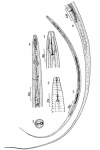
Cephalenchus leptus (from Siddiqi, 1963)
1. Cephalic end of female; 2. Amphid and sensillar sac;
3. Cross-section of head showing sclerotization of amphidial pouches; 4.
Oesophageal region of female; 5. Female 6. Caudal end of female .
|
- Body much attenuated;
- lip region 1/3 of the body-width at neck
base,
- long filiform tail.
- Cuticle coarsely striated; annules
distinct, 2um wide near mid-body.
- Lateral fields interrupting transverse
striations, marked by six longitudinal incisures,
- Deirids a pair of distinct pores, located
in the middle of lateral fields at the level of the excretory pore
- Head rounded, set off from body by a deep
constriction,
- Oral opening small, oval, surrounded by six
amalgamated lips; lateral lips enlarged, bearing small, oval
amphidial apertures. Amphids with abnormally sclerotized pouches;
- Stylet slender, 17um long, 17% of esophageal
length, conus slighlty than shaft; basal knobs distinct, with outer
margins directed outward and forward
- DEGO 2 um from base of spear.
- Procorpus of esophagus short and broad, equal to
spear in length. Metacorpus well-developed, rounded,
- Sub-ventral esophageal glands opening just
posterior to thickening in center of metacorpus.
- Isthmus slender, elongate, twice the length
of procorpus,
- Basal oesophagcal bulb sac-like, with three
gland nuclei, slightly extending over anterior end of intestine the
right side
- Eesophago-intestinal valve conoid-rounded.
- Excretory pore located one body-width
behind the level of the metacorpus.
- Vulva a depressed transverse slit; vagina leading
inwards, at right angles to body axis; posterior uterine sac 20um
long, about 1.5x vulval body diameter.
- Spermatheca absent; no trace of sperms in
uterus.
- Tail long, filiform, much attenuated, 27 times
anal-body-width long; tail terminus acuminate.
|
|